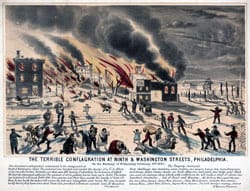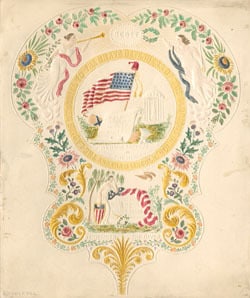Staff News

The Terrible Conflagration at Ninth and Washington Streets, Philadelphia. On the Morning of Wednesday February 8th 1865 (Philadelphia: J. L. Magee, 1865). Lithograph, hand-colored.
Following her participation in two recently-completed grant projects, Associate Curator Erika Piola presented a paper and had an article published based on her work. At the recent Center for Historic American Visual Culture conference “Historical Prints: Fact or Fiction” Ms. Piola discussed her research on sensational news event lithographs in her talk “Great and Terrible: Lithographs of Public Celebrations and Tragedies in Nineteenth-Century Philadelphia.” Based on her research of these prints for the Philadelphia on Stone project, which examined the early years of commercial lithography in Philadelphia, Ms. Piola compared views of parades and man-made disasters with newspaper accounts of the events to explore their accuracy.

The Ladies Memorial to the Brave Defenders of this Glorious Union (Philadelphia: C.Y. Haynes, ca. 1862). Embossed fan.
Ms. Piola also served as the visual materials cataloger for the John A. McAllister project. She cataloged a number of pieces of Civil War-era stationery ephemera, including envelopes, fans, and paper toys. Intrigued by questions of their marketing and distribution, Ms. Piola drafted an article about how this material reflected women’s and children’s roles in the war. In October 2010, the journal of the Ephemera Society of America published her essay “‘For the Million’: Civil War Stationery Ephemera for Women and Children in the McAllister Collection at the Library Company of Philadelphia.” The heavily-illustrated article explores the significance of ephemera, including envelopes pre-printed with addresses of women “desirous of corresponding with soldiers” and paper soldiers, in understanding the popular culture of the Civil War.

Leave a Reply
Want to join the discussion?Feel free to contribute!